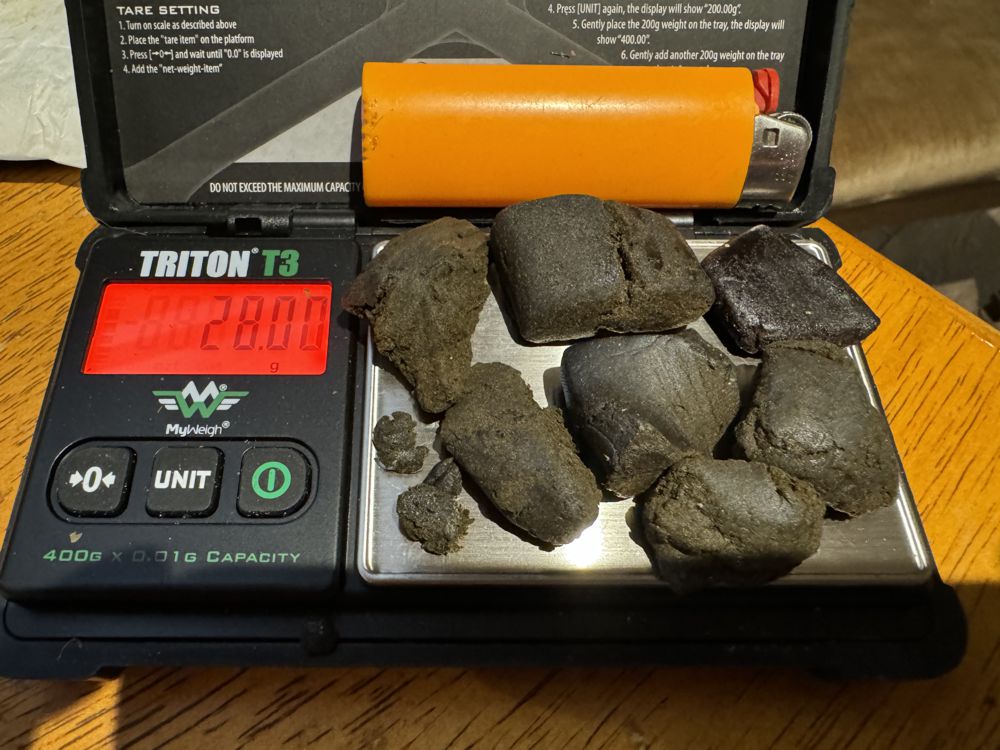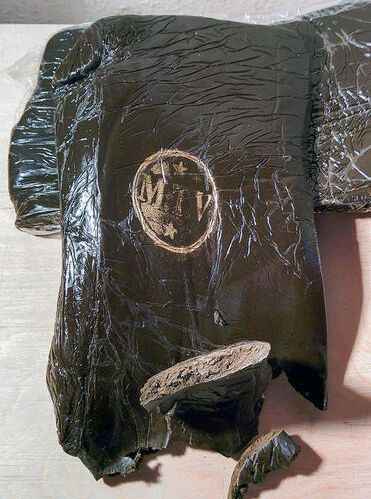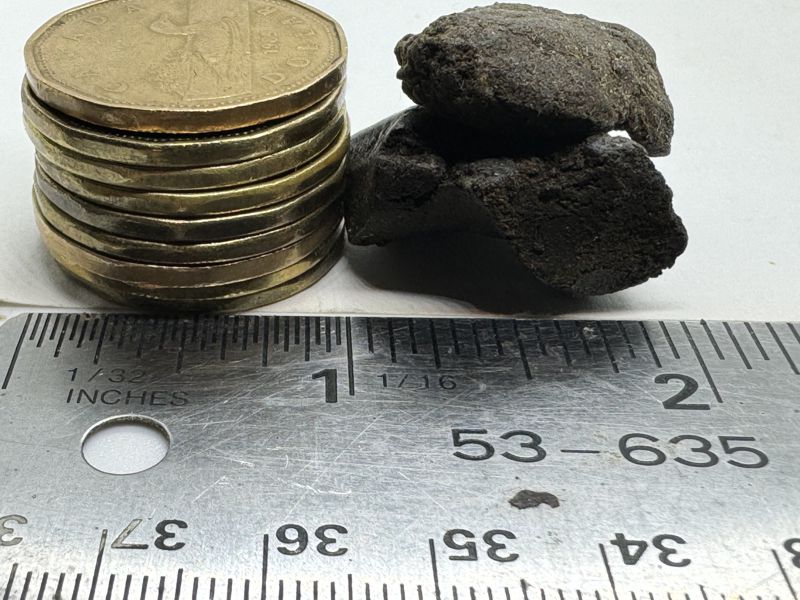Have you ever wondered what an ounce of hash looks like? Whether you’re a curious novice or a seasoned connoisseur, this article is here to unveil the mystery. Hash, derived from the resin of the cannabis plant, can come in various forms, each with its own unique appearance.
From the crumbly texture of bubble hash to the sticky consistency of finger hash, we will explore the fascinating world of hashish and help you visualize what a full ounce of this sought-after substance entails. Get ready to embark on a visual journey that will leave you informed and intrigued.
Physical Appearance of an Ounce of Hash
When it comes to the physical appearance of an ounce of hash, there are several characteristics that can help you identify and understand this concentrated form of cannabis. From its color variations to its size and weight, each element contributes to the unique appearance of hashish.

5 types of hash on my scale making up one ounce or 28 grams.
Size and Weight
The size an ounce of hash can vary, depending on its density and the production method used. Hash can be found in various forms, including thick slabs, small bricks, or even powder. A traditional ounce of hash is typically compressed into a solid block or slab-like shape, which can make it easier to handle and store. However, it is essential to note that the weight of a hash block may differ from the weight of the cannabis material used to produce it, as the extraction process removes some of the plant matter.
In grams, one ounce of hash equals 28 grams.
The 5 types of hash shown in the picture that equal one once are all reviewed, if interested, here are the reviews for each:

1 oz slab of black hash.
Comparing Hash to Coins
To get a better understanding of the physical appearance of an ounce of hash, let’s compare it to coins that you may be familiar with (in this case, I’m using the Canadian Loonie).
Hash vs Coins

When it comes to size and weight, an ounce of hash is often similar to a collection of coins or a thick stack of loonies. However, while coins have a uniform shape and size, hash blocks may vary in thickness and density. The comparison can help visualize the weight and compactness of hash, making it easier to comprehend its physical attributes.
Breaking Down What an Ounce of Hash Looks Like
- In the image above, 9 loonies stacked up equal the height of 7 grams of hash. The height = 5/8 of an inch.
- The width is about the same for the coin and the hash as seen on the ruler = 1 inch for each.
Final Dimensions for One Ounce of Hashish
- Height = 2.5 inches
- Width = 1 inch
So, one ounce of hash when compared to coins looks like a stack of 36 loonies measuring 2.5″ by 1 in diameter”.
Understanding the Scale: Hash Quantities
To navigate the world of hash, it is important to understand the different quantities in which it is measured. While grams and ounces are the most commonly used units, there are also other measures employed within the cannabis trade.
Grams vs Ounces
Grams and ounces are both units of measurement used to quantify the amount of hash. A gram is a smaller unit of measure, with one ounce equivalent to approximately 28 grams. Grams are commonly used for smaller, personal consumption quantities, while ounces are typically utilized for larger amounts, including distribution and trade within the industry.
Why Measure in Ounces
The use of ounces as a standard measure for hash can be traced back to historical and cultural practices within the cannabis trade. Ounces provide a convenient unit of measurement for larger quantities, making it easier to distribute and trade hash within the industry. While grams are commonly used for smaller personal consumption quantities, ounces remain prevalent in the broader market.
Common Measures Used in Cannabis Trade
In addition to grams and ounces, the cannabis trade often employs other measurements to quantify hash quantities. These measures include eighths, quarters, and half ounces, which are more convenient when purchasing smaller quantities. For example, an eighth of an ounce is approximately 3.5 grams, while a quarter is around 7 grams.
Hash Density: How Compact Is An Ounce Of Hash
The density of hash refers to how tightly the resin glands are packed together within a given volume. The density of an ounce of hash can vary based on several factors, including the production method, the quality of the input material, and the processing techniques employed.
Factors Determining Density
The density of hash is primarily influenced by the pressure applied during the extraction and processing stages. Higher pressure generally results in a more compact hash, while lower pressure can lead to a softer and more malleable texture. The resin content and the trichome structure of the cannabis strain used also play a role in determining the overall density of the hash.
How Density Affects Appearance
The density of hash directly impacts its physical appearance. A more compact and dense hash will have a firmer texture and may appear darker in color due to the compression of the resin glands. On the other hand, a less dense hash will be softer to the touch and may have a lighter color, with the resin glands retaining their individual structure.
Factors Affecting the Appearance of an Ounce of Hash
Several factors can affect the appearance of an ounce of hash, beyond its physical characteristics. The quality of the cannabis used, the method of extraction, and the storage methods employed all contribute to the overall appearance and quality of the final product.
Quality of Cannabis
The quality of the cannabis used in the production of hash plays a significant role in its appearance. Higher-quality cannabis with a high resin content will generally result in a more potent and desirable hash. The strain, growing conditions, and curing techniques can also influence the color, aroma, and flavor profile of the hash.
Method of Extraction
The method of extraction employed to obtain the resin glands from the cannabis plants can affect the appearance of hash. Different techniques and solvents can produce varying results, influencing the color, texture, and potency of the final product. For example, traditional hand-rubbed hash may have a more natural and authentic appearance compared to hash made using modern extraction processes.
Storage Methods
Proper storage methods of hash are crucial for maintaining the appearance and quality of the cannabis concentrate over time. Exposure to light, heat, and oxygen can degrade the hash, leading to changes in color, aroma, and potency. Storing hash in a cool, dry, and airtight container can help preserve its appearance and ensure its longevity.
Characteristics of Hash
Hash is a concentrated form of cannabis that is produced by extracting resin from the plant material. It is typically brown or black in color and has a sticky, soft, and malleable texture. Its appearance can vary depending on the production method and the quality of the cannabis used. Hash is known for its potent aroma and rich flavor, which are a result of the concentrated resin content.
Color Variations
The color of hash can vary significantly, ranging from light golden to dark brown or black. These color variations are influenced by several factors, such as the quality of the cannabis used, the extraction method, and the processing techniques employed. Lighter colored hashes, often referred to as “blonde hash,” are typically made from high-quality cannabis and are considered to be more potent. On the other hand, darker colored hashes, sometimes known as “black hash,” may contain more impurities and have a slightly different taste profile.
The Quality and Potency of Hash
The quality and potency of hash are key factors that not only impact its appearance but also determine its overall value and effects.
How Potency Impacts Appearance
Potency refers to the concentration of cannabinoids, such as THC and CBD, in hash. A more potent hash will have a higher concentration of these compounds, leading to more pronounced effects. In terms of appearance, highly potent hash may exhibit a darker color and a stronger aroma, indicative of the rich resin content.
Signs of Good vs. Bad Quality Hash
Several signs can indicate the quality of hash. Good quality hash will have a pleasant aroma, a rich flavor profile, and a smooth texture. It should have a potent effect when consumed, providing the desired therapeutic and recreational benefits. On the other hand, poor quality hash may have a harsh taste, a weak smell, and a less desirable texture. It may also produce undesirable effects, such as headaches or a lack of potency.
Different Forms of Hash
Hash is available in several different forms, each produced using distinct extraction techniques. These forms include pressed hash, bubble hash, and charas, each with its own unique attributes that contribute to its appearance and characteristics.
Pressed Hash
Pressed hash, as the name suggests, is created by compressing the resin glands obtained from cannabis plants. The result is a solid block or brick-like form of hash with a relatively firm texture. Pressed hash tends to have a uniform appearance, with a smooth surface that may feature imprinted patterns from the compaction process. Its density can vary, depending on the pressure used during the pressing process.
Bubble Hash
Bubble hash is made using a process that involves ice water and agitation to separate the resin glands from the plant material. This technique creates a granular or powdery form of hash that ranges in color from light to dark brown. Bubble hash has a soft and crumbly texture, resembling small pieces of sand or fine sugar crystals. Its appearance can be slightly grainy or sandy due to the separation process.
Charas
Charas is a traditional form of hash that originated in the Indian Himalayas. It is made by hand-rubbing the resinous flowers of cannabis plants. Charas has a sticky and pliable texture, often resembling a dark brown or black putty that can easily be shaped and rolled into small balls or snakes. Its appearance is unique, as it retains the natural oils and resins from the plant, offering a more authentic representation of the cannabis strain used.
Conclusion
The physical appearance of an ounce of hash was clearly defined in the pictures I provided, I hope this helped you visualize what an ounce of hash looks like. It is also influenced by various factors, including color variations, size, weight, and the production method used.
Hash quantities are measured in grams and ounces, with other measures like eighths and quarters also common in the cannabis trade. The density of hash affects its appearance, with factors like the quality of cannabis, extraction methods, and storage methods playing a role.
Legalities and measurements are important to consider, with ounces remaining a prevalent unit of measurement in the cannabis industry. The quality and potency of hash impact its appearance, and it is vital to distinguish between good and bad quality hash.
Cheers,
The Chronic Beaver

